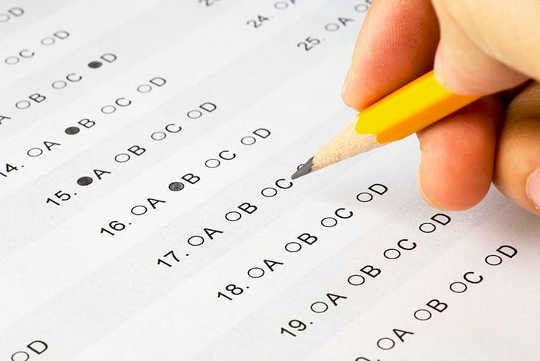 Results are better if students are allowed to sleep in. Alberto G., CC BY
Results are better if students are allowed to sleep in. Alberto G., CC BY
Standardized tests have become the primary tool for determining a student’s academic ability. Legislators and administrators use test data to evaluate the effectiveness of schooling on children and create curriculum.
Their use is supported by two fundamental assumptions: that the tests do not have a bias, and that they accurately assess a student’s academic knowledge.
A typical standardized test assesses a student’s knowledge base in an academic domain, such as science, mathematics or reading. When taking a standardized test, it is assumed that the substance of the test and its administration will be the same for all takers. The tests are identical, with identical degrees of difficulty and identical grading methods.
Despite these goals in the creation of standardized tests, recent research I conducted in collaboration with Hans Henrik Sievertsen (of the Danish National Center for Social Research) and Marco Piovesan (of the University of Copenhagen) identifies one potential source of bias: the time at which students take the test.
Why timing matters
We used data from a context in which the timing of the test depends on the weekly class schedule and computer availability at the school. Thus, students and teachers do not choose when the test occurs: the test time depends on factors outside of their control. Though our data come from Denmark, the same conditions often exist in the case of tests in other countries across the globe.
But does the time of the day when students take the test make a difference in terms of their performance on the test? We thought it would.
After all, people’s ability to perform effectively on various tasks is not constant across the day but shows temporal variation. In fact, research has argued that individuals’ cognitive functioning (e.g., memory and attention) is at its peak at their optimal time of day and decreases substantially at their nonoptimal times. Others have suggested that time-of-day effects on performance depend on external factors that occur at particular times (e.g., meals) or vary depending on the nature of the task itself.
Given these various theories about how time of day affects performance, we had a unique opportunity to put these hypotheses to a test as we gained access to data on the full population of children in Danish public schools from 2010 to 2013.
As the day wears on, students (as we all do) become increasingly fatigued. So, we reasoned, “cognitive fatigue” (i.e., when the brain has to work harder to concentrate on tasks) can lead students to perform worse on tests taken later in the day and that breaks can recharge students’ energy.
So, “cognitive fatigue” negatively impacts test performance. But a break can counterbalance this negative effec. For example, during a break, children in school can have something to eat, relax, play with classmates or just have some fresh air. These activities recharge their energy.
How timing matters
Our results are consistent with these hypotheses.
To test whether our intuition was right, we linked two million standardized tests taken in Denmark by children between the age of eight and 15 with the time the test was administered.
In Denmark, these tests are computer-based: to test the students, teachers have to prebook a test session within the test period (which runs from January to April of each year). Therefore, the test time is determined by the availability of a computer room and students’ class schedules. And, in fact, our analysis confirms that students are allocated to different times randomly.
Our analyses led to three main findings: 1) The later in the day the time of the test is, the lower the performance on the test; 2) breaks cause a significant improvement in performance; 3) the effect of time of day and of breaks are not homogeneous – low-performing students are more affected by breaks (and also by the time of the day when the test is taken) than high-performing students.
Here is how to think more concretely about the size of our results:
We found that when the standardized test is taken an hour later in the day, it causes a deterioration in a student’s test score that corresponds to parents having about US$1,000 less in their household annual income or students going to school for 10 fewer days every year. A break causes an improvement in a student’s test score that corresponds to parents earning about $1,900 more in their household annual income or students going to school for 19 extra days every year.
We were able to identify these estimates based on additional analyses of our data that we conducted to better understand the impact of taking the standardized test later in the day to find concrete numbers to compare our effects to.
The effect sizes may seem small, as these estimates suggest, but they are quite sizable compared to the influence of individual characteristics on students' test performance and the implications of these findings.
When’s the right time?
In reading about these results, one may be tempted to interpret them as evidence that the start time of the school day should change to later thus allowing students to sleep in – a topic that is currently debated quite often in the United States among other places.
One may reach this conclusion since, by starting the school day later and getting some more sleep (which is well-known) to be a way to restore one’s mental energy), students may be able to perform better on their tests and other school activities throughout the day.
Our results should also not be interpreted to say that schools tests should be administered earlier in the day.
Rather, the message of this research for policy-making is twofold.
First, when policymakers or schools administrators make decisions regarding the length of the school day and the frequency and duration of breaks, “cognitive fatigue” should be taken into careful consideration. Longer school days can be justified, our research suggests, as long as they include an appropriate number of breaks. Second, it is important for school accountability systems to control for the influence of external factors on test scores.
We rarely ask the question of whether it is the right time to take a test. But, our research suggests, this may be an important question to ask going forward given that, as the day wears on, students (like all of us) become increasingly fatigued and consequently more likely to underperform on a standardized test.
About The Author
Related Book:
at InnerSelf Market and Amazon























